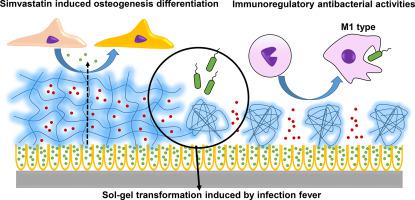Biomaterials Advances ( IF 5.5 ) Pub Date : 2021-01-13 , DOI: 10.1016/j.msec.2021.111878 Baoe Li , Lei Zhang , Donghui Wang , Feng Peng , Xuefeng Zhao , Chunyong Liang , Haipeng Li , Hongshui Wang

|
Although Ti is widely used in orthopedic implants, its bio-inert characteristics and poor antibacterial activity may result in implant failure. To counter this problem, in this study, we loaded simvastatin, a bioactive compound that promotes osteogenesis, in TiO2 nanotubes and a thermosensitive chitosan-glycerin-hydroxypropyl methyl cellulose hydrogel (CGHH) was then layered on top of these nanotubes. At normal human-body temperature (37 °C), CGHH was present in a sol state, thus facilitating the controlled release of simvastatin to enhance differentiation in MC3T3-E1 osteoblasts. In vitro cell-culture studies suggested that CGHH in a gel state would induce macrophage polarization to the pro-inflammatory M1 phenotype. In vitro testing against Escherichia coli and Staphylococcus aureus indicated no antibacterial activity in CGHH in both sol and gel states. However, the results of subcutaneous infection animal models suggested that CGHH showed excellent in vivo antibacterial activity, which can be explained by the fact at high temperatures induced by an infection, CGHH transitioned into a gel state and released large amounts of glycerin. Such a high glycerin dosage induced an acute inflammatory reaction and antibacterial activity. Thus, due to their enhanced osteogenesis capacity at normal body temperature and antibacterial characteristics in the presence of infection, the newly designed simvastatin-loaded CGHH-encapsulated TiO2 nanotubes are promising materials for application in orthopedic implants.
中文翻译:

具有控制药物释放和免疫调节特性的热敏性水凝胶涂层二氧化钛纳米管,用于骨科应用
尽管Ti已广泛用于整形外科植入物中,但其生物惰性和不良的抗菌活性可能会导致植入物失效。为了解决这个问题,在这项研究中,我们在TiO 2纳米管中装载了辛伐他汀(一种促进骨生成的生物活性化合物),然后将热敏壳聚糖-甘油-羟丙基甲基纤维素水凝胶(CGHH)层叠在这些纳米管的顶部。在正常人体温度(37°C)下,CGHH以溶胶状态存在,从而促进了辛伐他汀的控释,从而增强了MC3T3-E1成骨细胞的分化。体外细胞培养研究表明,处于凝胶状态的CGHH会诱导巨噬细胞极化至促炎性M1表型。体外测试大肠杆菌和金黄色葡萄球菌在溶胶和凝胶状态下均未显示CGHH具有抗菌活性。然而,皮下感染动物模型的结果表明,CGHH表现出优异的体内抗菌活性,这可以通过以下事实来解释:感染引起的高温下,CGHH转变为凝胶态并释放出大量甘油。如此高的甘油剂量引起急性炎症反应和抗菌活性。因此,由于新设计的载有辛伐他汀的CGHH包埋的TiO 2具有增强的在正常体温下的成骨能力和感染时的抗菌特性,因此 纳米管是用于骨科植入物的有前途的材料。











































 京公网安备 11010802027423号
京公网安备 11010802027423号